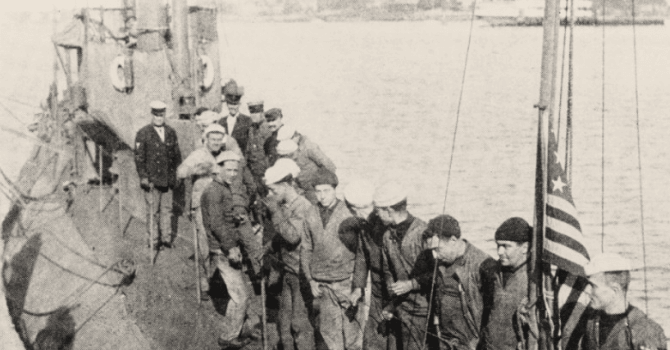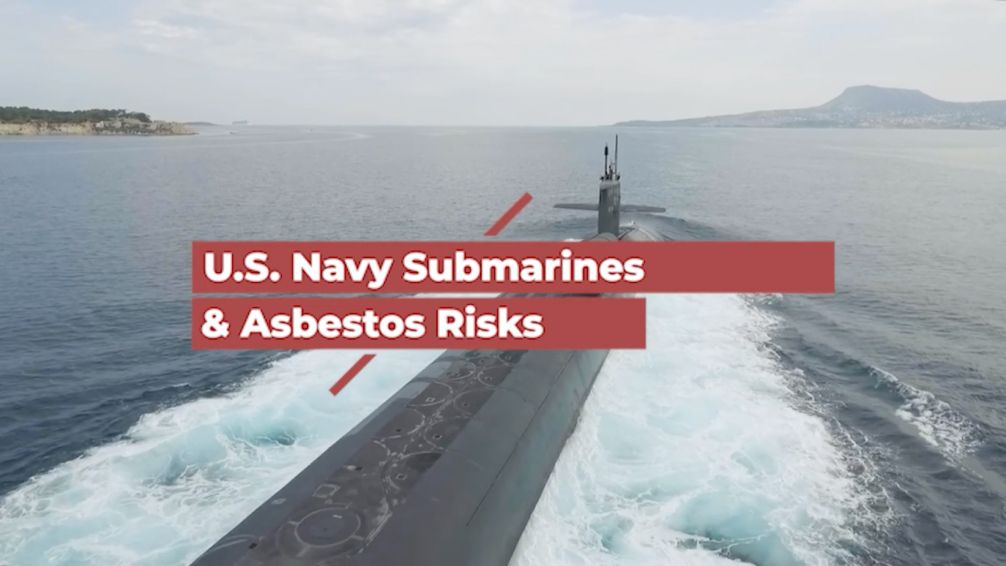The U.S. Navy used asbestos products in every submarine for decades. In total, nearly 400 submarines are known to have contained asbestos. Any Navy veteran exposed to asbestos on submarines is at risk of mesothelioma and other illnesses. We can help veterans with mesothelioma and their loved ones pursue VA benefits, health care, and compensation.
Is There Asbestos on Submarines?
Yes, there was asbestos on virtually all U.S. Navy submarines from 1922 through the early 1980s.
Asbestos-containing products like insulation, gaskets, and valves were used to keep submarines fireproof and durable. However, Navy veterans could develop mesothelioma later in life if they were exposed to asbestos on submarines
Video Summary: Almost 400 Navy submarines were built with asbestos, a material that causes mesothelioma. Get help if you served on a submarine and now have this cancer by calling (877) 450-8973. View Transcript
As early as World War I, the U.S. Navy relied on a substance called asbestos when building submarines.
Asbestos is a very durable mineral that can cheaply be used as insulation aboard Navy submarines and other vessels in pipes, insulation, flanges, and more.
Nearly Over 400 U.S. Navy submarines and thousands of other Navy ships were built with asbestos due to government mandates.
But, asbestos exposure can cause a fatal cancer known as mesothelioma decades later. One-third of all mesothelioma cases can be linked back to Navy service. There’s no cure for mesothelioma, and the prognosis is often poor.
Thankfully, U.S. Navy veterans who have mesothelioma after serving aboard submarines can access a wealth of medical and financial resources.
Some of the most crucial benefits are offered by the U.S. Department of Veterans Affairs, including monthly disability payouts, free or low-cost mesothelioma treatments, and financial support for the veteran’s family members.
Additionally, veterans can also file private claims against the makers of asbestos-containing products. These claims may award additional compensation without affecting the veteran’s ability to file for VA benefits.
The Mesothelioma Veterans Center is proud to help veterans and families who’ve been impacted by this aggressive cancer obtain the justice they deserve. Reach out to us today to get started.
If you have mesothelioma from Navy submarines, we may be able to help you access U.S. Department of Veterans Affairs (VA) benefits, cancer treatments, and compensation.
Get a Free Veterans Packet now to see all the ways we can assist you and your loved ones.
List of U.S. Navy Submarines With Asbestos
Almost 400 U.S. Navy submarines were built with asbestos to help with fireproofing and durability. Navy service members didn’t know they were at risk since manufacturers of asbestos products hid the risks for decades.
U.S. Navy submarines with asbestos included:
- USS Abraham Lincoln (CVN-72)
- USS Albacore (AGSS-569)
- USS Alexander Hamilton (SSBN-617)
- USS Andrew Jackson (SSBN-619)
- USS Argonaut (SS-166)
- USS Atlanta (SSN-712)
- USS Atule (SS-403)
- USS Balao (SS-285)
- USS Baltimore (SSN-704)
- USS Baton Rouge (SSN-689)
- USS Birmingham (SSN-695)
- USS Boston (SSN-703)
- USS Bremerton (SSN-698)
- USS Bumper (SS-333)
- USS Cabezon (SS-334)
- USS Cabrilla (SS-288)
- USS Casimir Pulaski (SSBN-633)
- USS Catfish (SS-339)
- USS Cavalla (SSN-684)
- USS Cincinnati (SSN-693)
- USS Dallas (SSN-700)
- USS Dolphin (AGSS-555)
- USS Entemedor (SS-340)
- USS Escolar (SS-294)
- USS Finback (SSN-670)
- USS Flasher (SSN-613)
- USS Flier (SS-250)
- USS Flounder (SS-251)
- USS Flying Fish (SSN-673)
- USS Francis Scott Key (SSBN-657)
- USS Gabilan (SS-252)
- USS Gato (SSN-615)
- USS George Bancroft (SSBN-643)
- USS Glenard P. Lipscomb (SSN-685)
- USS Groton (SSN-694)
- USS Haddo (SSN-604)
- USS Halibut (SSN-587)
- USS Hammerhead (SSN-663)
- USS Houston (SSN-713)
- USS Icefish (SS-367)
- USS Indianapolis (SSN-697)
- USS Irex (SS-482)
- USS Jacksonville (SSN-699)
- USS James Madison (SSBN-627)
- USS Kamehameha (SSN-642)
- USS Kete (SS-369)
- USS Kingfish (SS-234)
- USS Kraken (SS-370)
- USS L. Mendel Rivers (SSN-686)
- USS La Jolla (SSN-701)
- USS Lamprey (SS-372)
- USS Lancetfish (SS-296)
- USS Lewis and Clark (SSBN-644)
- USS Los Angeles (SSN-688)
- USS Medregal (SS-480)
- USS Memphis (SSN-691)
- USS Mero (SS-378)
- USS Michigan (SSGN-727)
- USS Nautilus (SSN-571)
- USS New York City (SSN-696)
- USS Omaha (SSN-692)
- USS Paddle (SS-263)
- USS Parche (SSN-683)
- USS Philadelphia (SSN-690)
- USS Pollack (SSN-603)
- USS Queenfish (SSN-651)
- USS Quillback (SS-424)
- USS Rasher (SS-269)
- USS Raton (SS-270)
- USS Razorback (SS-394)
- USS Richard B. Russell (SSN-687)
- USS S-1 (SS-105)
- USS S-10 (SS-115)
- USS S-13 (SS-118)
- USS Sailfish (SS-572)
- USS Salmon (SS-573)
- USS San Francisco (SSN-711)
- USS Seawolf (SSN-575)
- USS Snook (SSN-592)
- USS Spearfish (SS-190)
- USS Tautog (SSN-639)
- USS Tecumseh (SSBN-628)
- USS Tench (SS-417)
- USS Tunny (SSN-682)
- USS V-3 (SF-6)
- USS V-4 (SM-1)
- USS Volador (SS-490)
- USS Von Steuben (SSBN-632)
- USS William H. Bates (SSN-680)
- USS Will Rogers (SSBN-659)
Please note that this is only a partial list of U.S. Navy submarines that contained asbestos. You may have been exposed to asbestos on submarines even if a ship you served on isn’t listed above.
In addition, thousands of other U.S. Navy ships were built with asbestos, putting millions of service members at risk of mesothelioma.
U.S. Navy Submarine Jobs and Asbestos Dangers
Any U.S. Navy veteran who served on submarines before the 1980s may have been exposed to asbestos. However, certain jobs carried a greater risk of asbestos exposure and mesothelioma from submarines.
Jobs with a high risk of exposure to asbestos on submarines included:
- Boiler room workers
- Electricians
- Engine room workers
- Insulators
- Machinists
- Pipefitters
- Plumbers
- Welders
These Navy service members may have handled asbestos-containing products on a daily basis, unknowingly breathing in or swallowing toxic fibers.


Norm Laurence was diagnosed with mesothelioma shortly after retiring. He had installed boiler plates on submarines during his time in the Navy and was also exposed to asbestos as a civilian.
It takes 10-50 years for asbestos-related illnesses to appear after exposure, so U.S. Navy veterans who served aboard submarines decades ago are still at risk today.
Shipyards and Mesothelioma Submarine Risks
Navy shipyard workers who serviced submarines were also in great danger of mesothelioma.
Up through the early 1980s, submarines and other ships were built, repaired, and dismantled at Navy shipyards across the country. All of these actions released fibers into the air, exposing shipyard workers on an everyday basis.
These Navy shipyards regularly serviced submarines containing asbestos:
- Charleston Naval Shipyard in South Carolina
- Ingalls Shipyard in Mississippi
- Newport News Shipbuilding in Virginia
Working on submarines in shipyards was especially dangerous since many of them were so cramped, meaning asbestos fibers had nowhere to go and could linger inside for long periods of time.
Products Made With Asbestos on Submarines


Asbestos materials were used in Navy submarines to help reduce the risk of fires, which could have been catastrophic if one started while the vessel was underwater.
Asbestos products on U.S. Navy submarines included:
- Flanges
- Gaskets
- Insulation
- Packing materials
- Piping
- Seals
- Tape
- Valves
- Water pipes
- Wire cloth
Navy sailors working with any of these products could have been exposed to asbestos fibers.
Since submarines were cramped and poorly ventilated — especially when underwater — asbestos fibers could get trapped in the air for hours at a time, putting all aboard at risk.
Get our Free Veterans Packet and see how you can access VA benefits, treatments, and compensation if you developed mesothelioma from Navy submarines.
Compensation Options for Asbestos Exposure on Submarines
If you were exposed to asbestos on submarines and now have mesothelioma, you may qualify for VA benefits and compensation worth $1 million or more.
Learn more about your mesothelioma compensation options below.
Mesothelioma Submarine Veterans Benefits
Mesothelioma is considered a 100% disability, and veterans with this cancer typically get over $4,000 per month through VA disability benefits.
Other VA benefits include free or low-cost mesothelioma treatments from VA doctors, financial compensation for next of kin, and other financial resources.
Our team can help you file for or increase your VA benefits right now.
Mesothelioma Lawsuits
Our partner law firm can help you file a mesothelioma lawsuit against companies that made the asbestos-based products that made you sick. These lawsuits typically award $1 million or more.
Past mesothelioma submarine lawsuits have awarded:
You can still get VA benefits after filing a lawsuit, and no legal action is taken against the U.S. military or government.
Get a free case review now to find out if you’re eligible to file a mesothelioma Navy submarine lawsuit.
Asbestos Trust Funds
Many asbestos companies filed for bankruptcy to avoid being sued, but these companies were forced to set aside money in trust funds to help victims.
As of 2025, there’s over $30 billion available across all asbestos trust funds.
You may qualify to file asbestos trust fund claims and access some of this compensation depending on which products you were exposed to.
History of Mesothelioma and Navy Submarines


The use of asbestos on submarines continued through World War II, the Korean War, and the Vietnam War.
Many types of submarines relied on asbestos, including:
- Attack submarines (SSK)
- Ballistic missile submarines (SSBN)
- Guided missile submarines (SSGN)
- Nuclear-powered submarines (SSN)
- Radar picket submarines (SSR)
In particular, nuclear-powered Navy submarines that used asbestos were seen as essential to winning the Cold War. As a result, asbestos use on submarines continued until the health risks became public knowledge.
Once the dangers became understood, the Navy stopped using asbestos to build new submarines. Renovation projects removed asbestos from existing vessels.
Today, no Navy submarines contain asbestos — but thousands of veterans have mesothelioma from being exposed decades earlier.
Did you get sick from asbestos on submarines? Call (877) 450-8973. You may be eligible for VA benefits, medical care, and legal compensation.
We Can Help U.S. Navy Veterans With Mesothelioma
Nearly 400 submarines built by the U.S. Navy contained asbestos, putting thousands of service members at risk of diseases like mesothelioma.
If you or a loved one served on a U.S. Navy submarine and has been diagnosed with this cancer, the Mesothelioma Veterans Center may be able to help you.
If eligible, you can work with our team to access:
- VA benefits worth $4,044.91 a month
- Cancer treatments from top VA doctors and hospitals
- Compensation worth over $1 million on average
- Other key resources to help you and your family
Get a Free Veterans Packet or call (877) 450-8973 now to find out all the ways we can assist you.
Mesothelioma and Navy Submarines FAQs
Is there still asbestos on Navy ships?
No U.S. Navy submarines contain asbestos today, according to a review of the Naval Vessel Register.
There are still asbestos-containing products on a handful of older U.S. Navy ships. However, these ships are regularly inspected to make sure the asbestos materials don’t pose a threat to human health.
What year did the Navy stop using asbestos?
The U.S. Navy stopped using asbestos on submarines and other ships in the early 1980s amid mounting evidence that exposure could cause cancers like mesothelioma.
However, private manufacturers knew the health risks of asbestos decades earlier and hid them to make significant profits.
As a result, many veterans have developed mesothelioma from Navy submarines and other ships that used asbestos-containing products.
What are the health issues with submariners?
Any U.S. Navy submariner could develop mesothelioma, lung cancer, asbestosis, or other diseases if they were exposed to asbestos.
Asbestos-related diseases like mesothelioma take 10-50 years to develop, so Navy submariners exposed to asbestos decades ago are still at risk today.
Call (877) 450-8973 for help if you or a Navy veteran you love developed mesothelioma from serving on a submarine.
What was asbestos used for in the Navy?
The U.S. Navy used asbestos on submarines since this material was heat-resistant, very durable, and not corrosive.
Further, the deadly dangers of asbestos weren't fully known to the general public until the early 1980s, so Navy personnel thought it was safe for decades.
Does the military still use asbestos?
The vast majority of military assets do not contain asbestos. Asbestos is only found in a small percentage of older ships and buildings where it wasn’t practical to remove the products in question.
The military no longer uses asbestos when constructing new submarines, other ships, or buildings.




